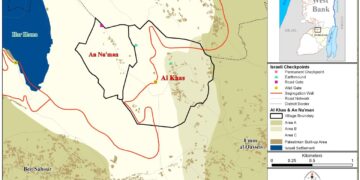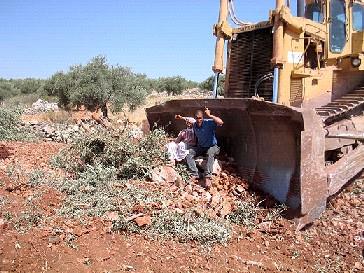Location and population
Shufa village is located 7 kilometers to the southwest of Tulkarem city and is 9 kilometers away from the Green Line. It is the mother town of the nearby Izbet Shufa and Khirebt Kafa. Many people from Shufa village settled in those two areas because of their fertile agricultural lands.Before the 1967 occupation, it houses a population of 750 people. Now, the population of the village is almost 2200. Since the 1967 occupation up to Year 2002, about 93% of Shufa's man power worked in the field of agriculture and in the Israeli construction sector, 5 % in trade and 2 % as civil servants. After 2002, 68% of the man power became jobless as a result of the Israeli military closure and restrictions of movement. The remaining percentages now work as civil servants, farmers and animal breeders. See location Map
The village of Shufa ( in red rectangular) bordered in the north west by Izbet Shufa and Kafa
The village area
The total area of Shufa village together with the neighboring Izbet Shufa nd Khirbet Kafa is 12000 dunums, out of which 2000 dunums are for built up areas, 4000 dunums cultivated with olive and almond trees, 4520 dunums for arid and grazing lands, 80 dunums cultivated with citrus trees, 200 dunums for agricultural roads and the remaining areas are used for irrigated agriculture.
There is a water-well in the village which produces 193000 cubic meters per month and is located 4 kilometers to the north of the village. This well is the only source of water for domestic and agricultural use in the village. It is run by the Shufa Cooperative Society for Drinking Water.
A profile of the Israeli violations against Shufa
Throughout the years of occupation, the village of Shufa has been a scene of continuous Israeli violations and terror actions committed against its people and their private properties. The following is a list of these violations:
1. In 1984, the village land came under an aggressive attack by the Israeli Hefetz group during which 44 dunums of fertile agricultural land in Wadi Isa north east of the village were seized by this group. A number of caravans were also erected on the confiscated land. Later on, permanent houses were built in this colonial post which now carries the name of Avnei Hefetz. See photo 1
The settlement of Afnei Hefetz in Wadi Isa, Photo courtesy of LRC
2. In 1987, another 1000 dunums were expropriated for the expansion of the above- mentioned settlement where new caravans were added and later replaced with permanent residential buildings formed of 4 housing units each.
3. In 1993, and as part of Oslo agreement and redeployment schemes, an additional 20 dunums were confiscated for the erection of a new Israeli military camp. The camp was built in the area of Khalet Ash Sheikh and became a source of fear for residents of Shufa village, especially children and women, because of its proximity from the village and due to the continuous firing of different types of ammunition around the clock.
4. During the same year of 1993, the Israeli occupation authorities constructed a colonial road at a width of 30 meters and a length of 7 km over land confiscated from the village. This road now links Israeli settlements in the area and Israeli proper. In consequence, at least 210 dunums of agricultural land were destroyed and hundreds of fruitful trees of different kinds were uprooted.
5. The continuous Israeli attempts to confiscate the only water-well in the village, but all these attempts were foiled.
6. In 1996, a group of Israeli settlers took control over hundreds of dunums of land located in the areas of Deir Aban and Wadi Atamer south of the village bringing mobile homes to these confiscated lands.
7. Since the beginning of the current Intifada, the Israeli army has split the village into two parts by digging up deep trenches in between and destroying Palestinian internal roads. Moreover, the army bulldozers destroyed the infrastructure in the village and blocked the movement of vehicles between the village and city of Tulkarem.
8. The IOF occupied the house of Mr. Saber Aref which overlooks the Israeli settlement of Avnei Hefetz after dismissing its dwellers from the house transforming into a military observation post. See Photo 2
Shufa- Tulkarem: The house of Mr. Saber Aref appeared in this picture at the hill top to the left of the road after being taken by the Israeli army. Photo courtesy of LRC
9. On March 19, 2004, dozens of fruitful olive trees located in the areas of Al W'ara, and Khirba south of the village were burned at the hands of Israeli settlers under Israeli army protection.
10. On July 11, 2004, a group of Israeli settlers from Avnei Hefetz set fire to 100 dunums of agricultural land causing damage to almost 150 trees. Local people and fire squads rushed to the scene in an effort to put off the fire, but the Israeli army blocked their way. The affected farmers presented a complaint to the DCO (District Coordination Office) and another one was presented to the Israeli Supreme Court, but no decision has yet been taken in favor of the victims. See Photo 3
Shufa- Tulkarem: Part of the land recently burned by settlers, Photo courtesy of LRC
In an interview with LRC field worker, Mr. Subhi Saleh Barqawi, a Palestinian farmer from Shufa village, he said: 'I plough my lands three times a year. I take care of it as much as I take care of my kids. And, in a sudden, an Israeli colonist comes and destroys every thing and goes unpunished. Is this a just thing to do? Or is it the law of the occupier?'
Prepared by
The Land Research Center
LRC

















